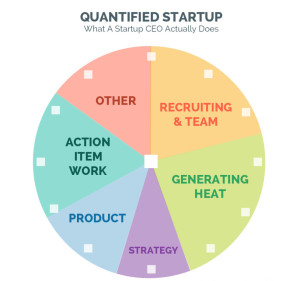Quantified Startup: What Does A Startup CEO in reality Do?
April 29, 2015
one of the most hardest questions to reply to as a startup CEO is “What do you actually do?” the reason that is one of these difficult question is that the answer varies day to day. there are a variety of well-written articles by means of successful entrepreneurs and VCs about what a startup CEO in reality does. On paper, a startup CEO’s job is to recruit prime tier talent, keep up a correspondence a transparent vision to the company’s stakeholders, and make sure the corporate doesn’t run out of money. in truth, this finally ends up taking type as a completely totally different beast; the everyday grind requires you to wear many different hats.
Methodology & Context:
to investigate how I break down my time as a CEO, I determined to quantify my day-to-day activities right through a regular week. Taking a couple of conventional Monday-Friday work weeks (for the sake of the learn about i didn’t include weekends although for a startup CEO, work weeks have a tendency to incorporate Saturday & Sunday), and i meticulously tracked how my time used to be disbursed on my calendar. while no week is identical at a fast moving startup, I did my highest to incorporate as with reference to ‘regular’ weeks as that you can imagine—which means no product launches or important air commute.
earlier than looking at the outcomes from my self-diagnosis, you will need to note that what you do as a startup CEO varies rather a lot relying on the type of company you’re operating, and the state of the trade. For me, Pixlee is a B2B company tool firm. Our conventional buyers are primarily advertising departments of mid-dimension to large manufacturers, so I spend quite a lot of my time speaking to buyers, than would a CEO of a B2C firm. Pixlee is a growing team of about 15, therefore maintaining individuals on the same web page occasionally requires extra conferences considering that you would be able to’t just “CC” everybody on every electronic mail like we have been in a position to when your entire group might fit into my automotive. lastly, having closed a seed round and experienced constant month over month earnings increase, we’ve moved prior the “simply stay alive” mentality. Now, extra of my time is being targeted towards growing the corporate.
Insights & Examples:
After analyzing all of my activities on my calendar for 2 weeks, i found that almost all of my tasks fell inside considered one of six buckets: Recruiting & team constructing, producing heat, technique & education, product, motion merchandise work, and different.

A breakdown of Pixlee CEO’s average week
1. Recruiting & crew building (21%):
As our crew starts offevolved to scale up, it’s the major responsibility of the CEO to build the perfect workforce possible, and to create an environment and culture where we may also be a hit. This was the one category that I hung out on daily, and it averaged out to about fifteen hours a week. On the recruiting side this incorporated constructing a pipeline of potential candidates, interviewing candidates, and then successfully closing them. On the workforce building facet, this included things like giving 1:1 remarks and website hosting bonding occasions like staff dinners and satisfied hours.
specific example: probably the most habitual activities all over these two weeks was onboarding new employees. all over these onboarding sessions, I are likely to center of attention on tradition and expectations as a result of it sets a groundwork for them to achieve success. I strongly believe that early stage startup CEOs should be extremely curious about now not just the recruiting process of recent workers but additionally in their integration into the crew and role.
2. producing heat (23%): This bucket is usually associated with exterior going through strategic opportunities that could create vital momentum on your company. inside this bucket I included situations such as necessary customer meetings, investor administration (each updating present investors and meeting new ones), and conversing opportunities at trade networking events. in the beginning, i did not spend much time on external facing alternatives, and most of this time was once spent assembly with new buyers. Now as our customer traction has picked up more of my time is spent assembly with doable strategic shoppers.
explicit instance: all over one week I was fortunate to have had multiple conferences with CEOs and CMOs of publicly traded companies. These shows require extra training as a result of you need to keep in touch your price prop as speedy and crisply as possible.
3. strategy & education (10%): “strategy” can mean different things, but for me it’s time to take into consideration our firm’s imaginative and prescient and our major priorities to get there. This generally entails conferences with different staff members around your product positioning, what options we will and won’t build, and dialogue over vital company decisions. because the CEO you need to be ‘a step in advance,’ and as one thing I wish I had more time for, I would like so to schedule more time to assume, plan, and prioritize.
explicit example: some of the necessary technique conferences we had was reviewing our end of the yr targets for the corporate and realigning a few of our advertising and product decisions to cohesively fit the bigger picture targets.
4. Product (13%): whereas I now not own the daily product management, I’m steadily involved with general product strategy. My position in product conversations has shifted from how does the feature work to what’s the use case for the client. a few of my time is spent with whiteboard sketches and discussions round how new features integrate with other components of our product. however, due to time constraints my major means of investing in product at Pixlee is spending time speaking with our shoppers.
explicit instance: One morning I had a two-hour breakfast with the chief workforce at one among our biggest consumers. the purpose of the conversation was to talk about how we can higher integrate Pixlee’s expertise with different aspects of their industry. Success during these meetings is ready asking the best questions and using these information points to affect product selections.
5. motion item Work (18%): recall to mind this as work that you simply do from your inbox and will get assigned in one of two methods: action items from conferences and e-mail requests. These tasks generally include issues like achieving out to specific shoppers, thanking recruits, investors, or advisors, inquiring for introductions, or reviewing paperwork.
explicit example: some of the vital duties on a daily basis is summarizing and sharing knowledge with the staff. Now that the staff is getting bigger advert hoc meetings aren’t the most effective option to keep in touch. Following up with written motion gadgets and takeaways can also be extra time consuming, however it’s essential to have everybody on the identical web page.
6. different (15%): These are the miscellaneous things corresponding to trip in between meetings, one off “espresso” events with chums or colleagues, and downtime activities corresponding to lunch, dinner, and ping pong. It additionally bills for time when you want to step in when issues go fallacious. sadly, you can’t plan in advance for issues going mistaken, however trust me you will be the primary to seek out out after they do.
particular example: Let’s simply say I sleep with my cell phone ringer on.
subsequent Steps:
After quantifying my agenda for two weeks i found that a majority of my time was once spent either recruiting or conversing with consumers. What’s most fascinating is how these duties have modified because our inception and the way they’ll alternate again as we develop.
business & Finance Articles on business 2 group
(111)













